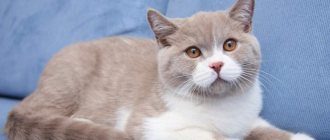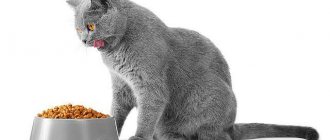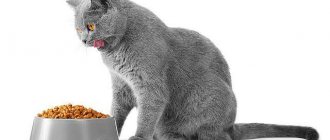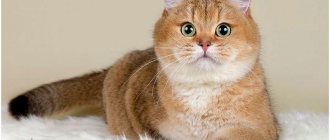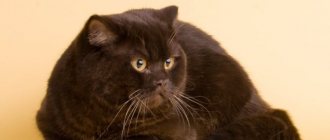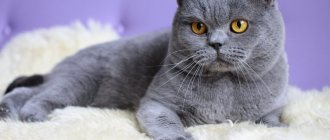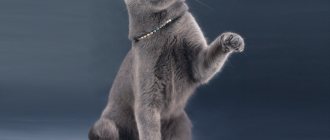WHITE BRITISH: COLOR STANDARD
The color of white British cats should be even, clean, uniform, each hair should be equally colored from top to bottom.
A white British cat should not have spots, stripes, or “smoky” dark hairs. There should also be no yellowness; it is most often found near the eyes, at the base of the tail and on the head. The nose and paw pads of a white British breed should be pink.
Important! In childhood, white kittens often have small spots (on the head), which indicates the absence of deafness. As the years progress, all these spots disappear.
The white British cat has an interesting feature: the fact is that the hairs are not white, and the color of the coat is hidden by the W gene.
Eye color in white cats can be in three variations:
- orange (BRI w 64)
- blue (BRI w 61)
- odd-eyed (BRI w 63)
GENETICS OF WHITE COLOR
The genetics of this color are one of the most interesting. The “W” gene is responsible for the white color, which seems to “hide” any other color under the white. In other words, under the white color there can be any other color that is “covered” with white paint.
And it’s not even entirely correct to call animals of a given color colored at all. After all, there is no pigment in their fur at all; more precisely, they are not colored.
White cats have the “W” gene - dominant. Genotype "WW" or "Ww". Cats with the “WW” genotype will produce offspring of only white color (regardless of what color the second sire is), and cats with the “Ww” genotype can produce offspring of both white and other colors.
The first sign of a white color is a pink nose and no rim, which is extremely important, because... many may confuse this color with the silver chinchilla.
Let's take a closer look.
W – white epistasis, covers all colors (dominant gene).
w – allows color to appear
The “W” gene also affects the hearing organs and eye color. Often white animals with blue eyes suffer from deafness.
Eye color in white cats depends on the “c” and “ca” genes.
“c” is a true albino, pink iris, “sa” is an albino with blue eyes.
INTERESTING TO KNOW
- White cats with blue eyes will most often be deaf, since this color is linked to hearing genes.
- Cats with different eye colors (one eye is blue, the other is golden) can be deaf in one ear - exactly on the side where the eye color is blue.
- This color, unfortunately, carries many mutations and often cats of this elegant color cannot boast of such excellent health as their colored counterparts, and their immune system is also weaker.
- Two white cats can produce a kitten of a different color (if the genetic formula of the parents looks like Ww+Ww)
- two non-white parents can never produce a white kitten (since the gene for white color - W - is dominant)
History of the origin of the breed
Historians are convinced that this cat breed was one of the first to appear. Moreover, there is information that animals were brought to Great Britain by the Romans. In ancient images you can see short-haired cream cats, as well as animals whose fur has other shades.
There is another version, according to which the Sacred Beauties came to England from France. The inhabitants of this country always took cats with them on voyages so that they would not allow rats and mice to eat the supplies. When stopping at British ports, the animals accidentally ended up on land.
Believing or not these theories is up to each person. One thing you can’t argue with is that snow-white fluffies are actually incredibly beautiful and gentle.
WHITE BRITISH CATS: PHOTOS OF ADULTS
Below is a gallery of photos of British cats and cats.
Advantages and disadvantages
Pedigree pure white kittens are bred by an officially recognized breeder, with membership in a cat club. The high price for a purebred kitten is justified by the purebred and exclusivity of the pet. These kittens have the following advantages:
- They have a certificate (passport) confirming all information about the breed:
- name of the breed,
- date of birth, kitten’s name, gender and color;
- the breed and nicknames of his parents; and
- information about the club and breeder.
- mark about the breeding class of the cat;
- purchase agreement
- Pre-familiar, predictable appearance and character of the animal.
- The British are well-bred, accustomed from an early age to the tray and scratching post.
- With proper care they are long-lived, up to 20 years
- Albinos are distinguished by their noble origin and prestige.
- Opportunity to participate in cat shows.
The disadvantages of snow-white British people include:
- Quite a price, determined by the breeding condition of the pet:
- show class for exhibitions;
- breed class for breeding;
- pet class for home, limited by the right of reproduction;
- Pets are excluded from the breeding class; white cats and female cats cannot be mated with each other.
- Snow-white kittens have genetic health problems: partial or complete deafness, decreased vision, loss of smell.
- Maintenance, care, food are expensive, especially for show class.
- The agreement provides:
- mandatory participation of a snow-white show-class pet in exhibitions;
- For the pet class, castration is recommended.
With all the advantages and disadvantages of the snow-white British, the main thing is to buy a healthy, sociable, affectionate pet. Surround your pet with care, attention, provide decent care and nutrition.
Source
WHITE BRITISH KITTENS: PHOTOS OF SMALL KITTENS
We are pleased to present photos of white British kittens.
| In our cattery you can “buy a real British kitten.” We have many different colors, we will help you choose and answer all your questions! |
British mating
To make you happy with the white, blue-eyed British, you need to take a responsible approach to choosing a partner. Pay attention to external data and do not forget to look at the veterinary documentation to avoid possible infection.
You should also remember about age; cats should not be kept under one year of age. Otherwise, the offspring will be sick, and kittens may be lost.
If you want to get a white longhaired British cat, then mating should only be done with white cats. And remember: the lady goes to mating with the gentleman, and not vice versa.
If you want to get yourself an affectionate and calm friend, with aristocratic manners, British kittens are an ideal option. Strong immunity, calm disposition and ease of care allow not only experienced breeders, but also amateurs to keep such animals.
Health issues
Since the British Folds were the result of interbreeding, the likelihood of genetic diseases among representatives of this feline species is very high.
British Folds are susceptible to genetic skeletal diseases
Thus, with age, osteochondrodysplasia may appear, expressed in lameness and deformation of skeletal bones (paws, vertebrae). This disease is incurable, so it is important to visit the veterinarian regularly if the kitten’s parents were two lop-eared individuals. If one of the parents had straight ears, the likelihood of pathology is significantly reduced.
In addition, British Fold cats are susceptible to typical diseases of all purring cats:
- viral infections (cat cold) - goes away on its own within two to three days, otherwise you should see a doctor;
- hypertrophic cardiomyopathy (heart pathology) - treatment is long-term (lifelong) and is supportive;
- polycystic kidney disease is an incurable disease; with maintenance therapy, cysts stop growing;
- claw fungus - can be cured with special antiseptic and antifungal solutions;
- infestation with parasites (worms, fleas) - preventive measures for deworming and getting rid of ectoparasites should be mandatory for representatives of the breed.
To maintain the health of your teddy pet, you must regularly visit the veterinary clinic for vaccinations. Vaccination begins at the age of 2.5 months and then every 3-6 weeks until the kitten is 15 weeks old.
This is followed by comprehensive annual vaccination against respiratory tract infections, panleukopenia, ringworm and rabies.
If you follow the rules for caring for your pet and carefully monitor the health of the British Fold, the animal will live up to 12–15 years.
Appearance
Standards for a British person's appearance were set in 1982. The model is considered to be a stocky animal with a wide chest, muscular body, strong rounded paws and short, plush-like fur. A feature of the breed is the presence of a rather large skin fold near the head. The nose is small, straight, wide.
Developed chin. The cheeks are plump and massive. The ears are small, neat, the same size in width and height. The medium-sized thick tail is rounded at the tip. The eyes are round, their color depends on the type of color of the breed. The average weight of a cat is from 3 to 5 kg, a cat - from 5 to 7 kg.
Features of breeding fold cats
All owners are advised to know that the breeding of any cat breed is fixed by the felinological club. To be officially bred, cats must take part in an exhibition. This is necessary to identify the presence or absence of breed defects.
Also during the exhibition, the cat is assigned the appropriate class. Among them:
- Pet class. Presence of breed defects. The animal is not allowed for breeding.
- Breed-class. Full compliance with the standard. Permission to breed.
- Show-class. The best of the breed. Permission to breed.
The felinological club also monitors the health of future offspring. Crossing a lop-eared male with a lop-eared female is prohibited, since such couples always give birth to kittens with genetic abnormalities.
Reproduction of Scottish Folds is possible only with straight-eared Scottish Folds.
It is very important for inexperienced owners to know about this feature of the fold-eared breed.
